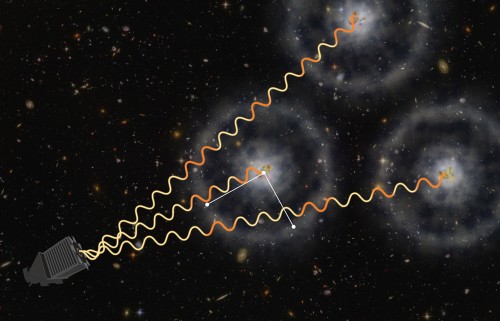
An artist’s illustration of how BOSS uses quasars to measure the distant universe. (Courtesy: Zosia Rostomian, Lawrence Berkeley National Laboratory; Andreu Font-Ribera, BOSS)
By Calla Cofield at the APS April Meeting in Savannah, Georgia
Scientists looking at data from the Baryon Oscillation Spectroscopic Survey (BOSS), the largest programme in the third Sloan Digital Sky Survey, have measured the expansion rate of the universe 10.8 billion years ago — a time prior to the onset of accelerated expansion caused by dark energy. The measurement is also the most precise measurement of a universal expansion rate ever made, with only 2% uncertainty. The results were announced at a press conference at the APS’s April meeting on Monday, at the same time that the results were posted on the arXiv preprint server.
The rate of universal expansion has changed over the course of the universe’s lifetime. It is believed to have gradually slowed down after the Big Bang, but mysteriously began accelerating again about 7 billion years ago (by rippstein). BOSS and other observatories have previously measured expansion rates going back 6 billion years.
To measure astronomical distances, astronomers will occasionally use so-called “standard candles” – these are supernovae with known luminosities. The difference between the known luminosity and the apparent luminosity indicates the supernova’s distance. The BOSS results measure the expansion factor of the universe using a “standard ruler” – a known distance between celestial objects. The expansion rate can be deduced when the known distance between two objects is compared to their apparent distance and each of their redshifts (the degree to which the light from those objects is stretched due to the expansion of the universe).
The “standard ruler” in this case is the imprint left over from sound waves in the early universe, also known as baryonic acoustic oscillations, or BAOs. These sound waves from the early universe should have created regularly spaced areas of high and low density in regular matter. For example, scientists see an excess of pairs of galaxies separated by about 450 million light-years – the length of the BAO ruler.
The BOSS experiment looked at the distance between quasars and nearby rings of gas. Quasars – galaxies with a supermassive black hole at their centre – are some of the brightest objects in the universe as a result of radiation from tremendous amounts of material falling into the black hole. Because the quasars formed in areas particularly dense with gas and dust, the imprint of the BAO is strong: it appears as a ring of gas roughly 450 million light-years away from the centre of the quasar.
“The scale of that ring is precisely this baryonic acoustic oscillation…and that’s what we’re trying to measure,” says Andreu Font-Ribera of Lawrence Berkeley National Laboratory and one of the authors on the new paper.
Quasars not only provide an imprint of the BAO, they are also some of the most visible objects at such great distances from the earth. Even supernovae or entire galaxies (of the non-quasar variety) are virtually invisible at a distance of 10.8 billion light-years from earth. The BOSS team studied more than 164,000 quasars to make their measurement.
Patrick McDonald, a researcher at Lawrence Berkeley National Laboratory, also spoke at the press conference. McDonald, who is doing research on BOSS data but is not an author on the new paper, says that measuring the universe’s rate of expansion could help scientists crack the mystery of dark energy. “We call it dark energy but that’s really a place holder at this point for us just not knowing how to explain this acceleration,” he explains. “To me it seems quite possible that it’s related to some fundamental hole in our understanding of physics.”
McDonald draws a comparison to the state of physics in the late 19th century, when inconsistencies in experiments attempting to measure the speed of light eventually gave way to entirely new worlds of physics, including quantum mechanics and general relativity. “This acceleration seems to me like one of our best clues to, possibly, something new like that,” says McDonald. “So that’s why we want to make these more accurate measurements.”
It is reassuring to hear dark matter described as a “place holder”, because, for the moment, we just do not know “how to explain this acceleration”.
New physics is always being invoked when something unexpected is found.
Maybe Physics is at a crossroad and great news are coming; maybe not.
We should be cautious; new bold ideas should stay restricted to technical papers, and specialized meetings,like this one.
We should not trade credibility for visibility.
What is the speed of quasar moving away in the study?
What a nice study and great idea. 164,000 quasars, each about 10.8 billion light years away and each showing (maybe) a nice baryonic acoustic oscillation ring, the distance of which from the center supernova is a known function of the expansion rate (or vice-versa) at or up to the time we see them. This is the sort of thing we can learn from “big data” at its best.